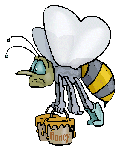
Honey - What is it?
The journey of Nectar from the Flower to Honey on the Table
Nectar is a sugar containing secretion from plant glands, on flowers or trees, called Nectaries.
The actual sugar content can vary widely depending on the flower source. Usually 20% to 40% sugar with other ingredients such as acids, salts, enzymes and aromatic substances.
The bee collects the nectar and stores it in a honey sac and carries it back to the hive where it is passed on to the house bees who continue the process of converting it to honey.
Conversion of Nectar to Honey involves 2 changes :- 1. chemical and 2. Physical
The chemical change is converting sucrose in the nectar to glucose and fructose by the enzyme invertase.
The physical change is evaporation of the water to bring the sugar concentration to 80% or higher. Bees cap the honey when it is 'ripe' with a thin layer of beeswax to keep out moisture. (Without this cap of beeswax the honey would absorb water from the atmosphere and start to ferment.) The Honey in the cell is perfect and is of the required standard to be offered for sale.
Average honey composition
18% water, 35% glucose, 40% fructose, 4% other sugars, 3% other substances. These other substances consist of 15 organic acids (acetic, malic etc.) 12 elements (potassium, calcium, sulphur etc.) 17 amino acids (proline, lysine etc.) and about 4 - 7 proteins (typically 0.2% except heather honey which is high in protein, 1.8%)
It is the 3% of other substances which give each honey type its colour, aroma and flavour, and honeys collected throughout the season will vary widely in characteristics making each unique.
All honey starts liquid but will eventually granulate because it is a supersaturated solution of more sugars than can remain in solution.
 Download Membership form
Download Membership form